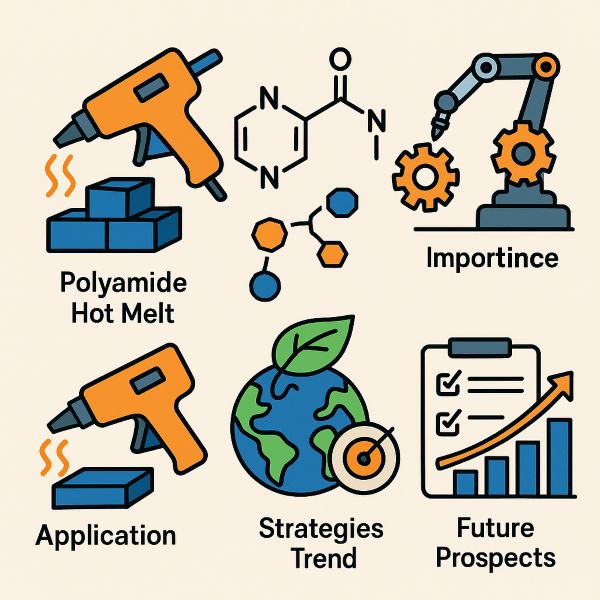
Understanding Polyamide Hot Melt
Importance in Industrial Use
Application Methods
Latest Trends in Polyamide
Strategies for Effective Use
Future Prospects
Frequently Asked Questions (FAQ)
Polyamide hot melt adhesives are essential for industries seeking durable and versatile bonding solutions. Known for their high bond strength, chemical resistance, and thermal stability, they are ideal for demanding environments such as automotive, packaging, and electronics. Their ability to maintain performance under stress makes them a top choice for efficient and consistent bonding.
Polyamide hot melt adhesives are vital in industrial production due to their mechanical strength and adaptability. Their resistance to heat, chemicals, and environmental stress makes them especially valuable in sectors like electronics assembly, automotive manufacturing, and high-speed packaging. Their rapid setting and consistent performance contribute to increased productivity and reduced rework, supporting scalable and reliable operations.
To fully utilize polyamide hot melts, it’s important to choose the right application technique:
Extrusion ensures precise application in continuous production lines.
Roll coating provides consistent coverage for large or flat surfaces.
Spray application allows flexibility on irregular shapes or surfaces.
Clean, dry substrates and accurate control of temperature and dispensing speed are crucial for optimal results. Matching application methods with adhesive properties helps maximize adhesion strength and operational efficiency.
The polyamide adhesive landscape is evolving with a focus on sustainability and performance:
Eco-friendly formulations are being developed to reduce emissions and increase bio-based content.
Heat- and cold-resistant variants are improving adaptability across extreme operating conditions.
Compatibility with automation systems is enhancing production throughput and consistency.
These innovations reflect industry-wide shifts toward greener, smarter bonding technologies that maintain high-performance standards.
To optimize polyamide hot melt performance in industrial settings:
Choose the adhesive based on specific performance requirements (e.g., heat resistance, flexibility, or speed).
Ensure substrate surfaces are clean, dry, and appropriately prepared.
Calibrate equipment for temperature, pressure, and feed rate to maintain consistency.
Perform regular equipment maintenance to prevent downtime and preserve application quality.
Strategic use of the correct product and process leads to better adhesion, reduced waste, and higher overall process efficiency.
The future of polyamide hot melt adhesives lies in sustainable innovation and manufacturing integration. Developments will likely include:
Environmentally responsible adhesives that meet global sustainability standards.
Advanced precision application technologies that reduce material usage and enhance accuracy.
Smart systems integration for real-time quality control and predictive maintenance.
These trends are set to reshape how adhesives are selected and applied, enabling industries to improve both product quality and environmental compliance.
What are polyamide hot melts?
They are industrial adhesives known for their strong bonding, resistance to heat and chemicals, and suitability for various applications.
Why are polyamide hot melts important in industrial use?
They provide consistent and reliable bonding in high-stress environments like automotive, electronics, and packaging, ensuring durability and performance.
What are the best application methods for polyamide hot melts?
Common methods include extrusion for accuracy, roll coating for uniformity, and spray application for flexibility across complex geometries.
What are the latest trends in polyamide hot melts?
Key trends include eco-friendly formulations, heat/cold resistance, and improved compatibility with automation and digital production systems.
By selecting the correct adhesive type, ensuring clean surfaces, maintaining equipment, and fine-tuning application parameters for consistent results.
What future prospects exist for polyamide hot melts?
Sustainability and smart manufacturing integration are expected to drive innovation, improving environmental impact and process efficiency.
Which polyamide hot melt products are recommended?
The selection depends on application needs. Choose adhesives rated for the required performance (e.g., temperature tolerance, speed, flexibility) from reputable industrial suppliers.